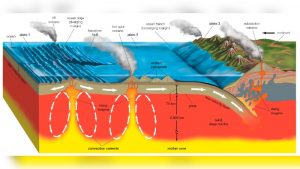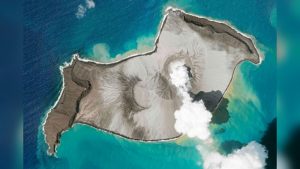When the Hunga Tonga Hunga Ha’apai volcano erupted in Tonga on Saturday, it sent a huge plume 30 kilometres into the sky and a literal shockwave around the world.
Every week there are around 20 volcanoes “showing some signs of unrest” across the globe, but most are fairly mild, says Scott Bryan, a volcano researcher at the Queensland University of Technology.
So what made this volcano so explosive, was the eruption predicted, will it erupt again soon, and are there other volcanoes we should be watching out for?
Why was it so explosive?

The Hunga Tonga-Hunga Ha’apai volcano is what is known as a subduction volcano.
Subduction zone volcanoes occur along tectonic plate boundaries where one plate is being forced down under another.
Subduction volcanoes tend to have dual personalities, according to Professor Bryan.
On the one hand, they have slow, passive eruptions that build the classic conical shape of volcanoes like Mt Fuji, and on the other they’re violently explosive, as we’ve seen in Tonga.
There are two factors that can lead to a highly explosive eruption, and although it’s still too early to say definitively, it appears both factors may have been at play on Saturday.
The first is a high concentration of pressurised water vapour and gases in the magma.
When that magma hits the surface from deep underground, there’s a sudden release of pressure “like opening a champagne bottle”, which causes the gases to explosively expand, blasting apart the magma or lava in the process.
In the case of Hunga Tonga-Hunga Ha’apai, researchers had previously looked at the chemical composition of the volcano’s lava sediment from an eruption in 2009.
They found the lava had ingredients for a powerful explosion, according to Heather Handley, a volcanologist from Monash University who was involved with that research.
“We could see from the chemistry of the rocks that the magma of that eruption was moving to the surface quickly and keeping hold of its gas as well,” Dr Handley said.
The second factor that made the Tongan volcano so explosive was that it was a sub-surface volcano — its lava vent was under the ocean.
When magma hits water, it causes an explosive interaction between the two as the water rapidly flashes to steam, Professor Bryan said.
“It’s the external addition of the water and the heat of the magma coming into contact with it,” he said.
The volcano’s vent was above water before disappearing below sea level just a few days (or hours) prior to Saturday’s catastrophic eruption, according to Dr Handley.

“The satellite images, if you compare from the 6th of January to two hours before the eruption, somewhere in that time frame the middle cone had gone,” she said.
A smaller eruption may have blown apart the cone, allowing the incursion of seawater into the vent, which then catalysed the larger eruption.
But Professor Bryan suspects an underwater slip or collapse may have magnified the eruption and caused the tsunami that went with it.
“You need to displace ocean water to make tsunamis,” he said.
“It’s more than just the eruption. Something else has happened underwater that’s triggered this explosion.”
Was the eruption predicted?
The Hunga Tonga-Hunga Ha’apai volcano was on a roughly 1,000-year eruption cycle, according to high-temperature geochemist Oliver Nebel of Monash University.
But that doesn’t mean we could have pinpointed with any real accuracy when it was going to erupt.
“We know … it’s due [to erupt], but that could mean yesterday or it could be in 100 years,” Dr Nebel said.
But there were some signs Hunga Tonga-Hunga Ha’apai was becoming more active, he said.

Dr Handley said the volcano entered a phase of increased activity sometime around December 19-20.
“In the past few weeks, you’ve been seeing what we call phreatomagmatic eruptions, where water and magma are coming into contact,” she said.
“You get these dark feathered plumes that come out.”
According to the database of the Global Volcanism Program, gas steam and ash plumes had risen at least 12.2 kilometres into the air by late December, but activity had “significantly decreased” by early January.
The difficulty in evacuating people when volcanoes enter more active phases is that often they may settle down again without a catastrophic eruption, Dr Nebel said.
Evacuating people any time a volcano showed signs of activity would not only be costly, but it would lead to an erosion of public trust in scientists, he added.
Will it erupt again soon?
When a volcano like this erupts, it often happens as a series of eruptions, rather than a one-off.
Records from the Global Volcanism Program show that the last period of activity at Hunga Tonga-Hunga Ha’apai, which began in December 2014, lasted just over a year.
During that period a new island was formed, about 120 metres high and about 2 kilometres long.
Dr Nebel said he suspected there would likely be more eruptions in the near future.
“It’s really hard, slash impossible, to predict whether it will be the same severity.”

A huge eruption like this one may mean that any following eruptions will be less intense; however, again, there are no guarantees.
The problem is that the magma chamber can be tens of kilometres deep, and there’s no way of knowing how much more magma is still in the chamber.
“The only thing we can say is that it has erupted now, so the likelihood of there being much more underneath is low, but we have seen [multiple large eruptions] before in the past,” Dr Nebel said.
Similarly, Dr Handley said it was “impossible to tell” at this point whether we had seen the biggest eruption, or if there were more to come.
Professor Bryan said if there was an underwater landslide that precipitated the eruption, that may actually be good news in terms of future eruptions.
“Hopefully if there was a landslide or whatever happened on Saturday, it’s stabilised the slopes to some extent,” he said.
“[In that case] we may have some explosions or tall columns, but we’re not going to get the tsunamis.”
Though the fallout and potential death toll is still unknown, Professor Bryan said the earlier eruptions at least gave the people of Tonga some forewarning of what may have been coming.
He also said the fact it happened in daylight was a small positive.
“By the sounds of it, most people saw the early signs. Obviously there was a sonic boom and they’d seen the columns from the weeks before.
“If this happened like three hours later in the middle of the night [when] people are asleep, it could have been a lot worse.”
Are there other volcanoes like this to watch out for?
Volcanoes like Hunga Tonga-Hunga Ha’apai are part of the Pacific Ring of Fire — a roughly 40,000km line around the Pacific Ocean tracing the edge of tectonic plates, where a large share of the world’s volcanoes are found.
However, these have what is referred to as an “independent magmatic plumbing system”, Dr Nebel said.
What that means is that their magma chambers and any conduits and vents are in no way connected to other volcanoes, and the eruption of one doesn’t precipitate the eruption of any others.
Across the world there are more than 1,300 active volcanoes, but active doesn’t mean erupting now, according to Dr Handley.
“To be active, we say they erupted in the last 10,000 years,” she said.
In any week there are around 20 volcanoes showing signs of activity, according to Professor Bryan.
The Global Volcanism Program listed 46 volcanoes as “in continuing eruptions status” as of December 9, 2021.
A number of these are in Australia’s Pacific neighbours, including Papua New Guinea, Solomon Islands and Tonga.
As we’ve seen, predicting which volcanoes may be an imminent threat to life can prove extremely difficult, but volcano experts say more monitoring and tsunami early warning systems can help.
“All of these volcanoes need monitoring, because our ability to predict these eruptions sometimes is in the order of hours,” Dr Nebel said.
SOURCE: ABC NEWS

